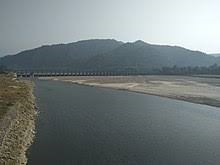Description

Disclaimer: Copyright infringement not intended.
Context
- A boat carrying 32 school students capsized in the Bagmati River in Bihar's Muzaffarpur on Thursday.
- Media reports said that the accident happened when the students were on the boat to go to the school.
- Based on the information, the locals rushed to the spot and rescued at least 18 students. However, more than 10 students are still missing and efforts are underway to rescue them.
Details
About
- Bagmati River is a transboundary river between the Nepal and India
- It starts its journey from Kathmandu, Nepal and it ends in the Koshi River near Bornesthan, Bihar, India.
- The total length of the Bagmati is 3 km.
- The Bagmati River flows through the Kathmandu Valley in Nepal and is separated from Kathmandu through Patan, traveling through Province No. 2 of Nepal's southern section before entering the Indian state of Bihar.
- A pair of religions, Hindus and Buddhists, regard this river as sacred.
- The Nepalese considered the Bagmati to be the source of their culture and urbanization.
- On the banks of the Bagmati, there are numerous cities and shrines. Furthermore, the population on the Bagmati's banks is dense, and the river is heavily polluted and filthy.
- The Bagmati is also significant because Hindus are burned on the ridges of the sacred creek, while Kirants are buried in the rocks by its flank.
- According to the Nepalese Hindu religion, the deceased body should be bathed three times in the Bagmati before entombment to stop the rebirth process.
Location
- The Bagmati River flows through Nepal's Kathmandu Valley.
- The river runs through the valley of Nepal's capital, passing through various important cities.

Origin
- The Bagmati River originates in the Shivapuri Hills north of Kathmandu and runs south through the city.
- The Nagarjun Forest Reserve, located near where the river begins its downstream journey, is a protected region abounding with species and breathtaking beauty.
Mouth of the Bagmati River
- The river eventually merges with the Narayani River.
- This confluence is located in southern Nepal, not far from the city of Triveni.
- The combined waters of the Bagmati and Narayani finally flow southward into the Ganges.
Basin features of Bagmati River
- The area around the Bagmati is full of beautiful vistas.
- The Kathmandu Valley, which is rich in history and culture, is right in its path.
- Numerous historical and cultural attractions, including several major temples and ghats (steps down to the river), may be found along the Bagmati's banks.
- Hindus see the Bagmati as sacred and possess great spiritual significance for them.
- The Pashupatinath Temple, located on the river's edge, is another famous Hindu pilgrimage site dedicated to Shiva.
- The riverbanks are a popular meeting spot for believers, who frequently gather to light funeral pyres and perform other religious rites.
- The Bagmati basin is also critical to the Kathmandu Valley's water supply.
- It aids farming activities, supplies drinking water, and maintains the local ecosystem.
Tributaries
- Several minor rivers fall into the Bagmati, which then flows downstream as one unit. The following are some of the major branches that feed into the Bagmati:
- The Bishnumati River flows across the Kathmandu Valley, past the modern city of Kathmandu and the historic city of Patan, from the Shivapuri Hills. It meets the Bagmati near Teku.
- The Manohara River, which flows through the northern part of the Kathmandu Valley, originates in the Nagarjun Forest Reserve.
- A major tourist spot is the confluence of the Guheshwori Temple and the Bagmati.
- The Dhobikhola River passes through Kathmandu and Tripureshwor on its journey from its headwaters in the Shivapuri Hills to the Kathmandu Valley.
- It is joined by the Bagmati shortly below Tripureshwor.
- The Bagmati River is vital to the residents of the Kathmandu Valley because of these and other tributaries, as well as several smaller streams and rivulets.
|
PRACTICE QUESTION
- Consider the following statements regarding the Bagmati River:
- Dhobikhola River and Manohara River are two tributaries of the Bagamati river.
- Shree Dwadasa Jyotirlinga temple is located on the Bagamati river bank.
- The Nagarjuna forest reserve is the best of feature of this river.
How many of the above statements is/are incorrect?
A) Only one
B) Only two
C) All three
D) None
Answer: A
|

https://www.newindianexpress.com/nation/2023/sep/14/boat-carrying-32-children-capsizes-in-bagmati-river-in-bihars-muzaffarpur-2614817.html
https://riversgraphy.com/bagmati-river/











